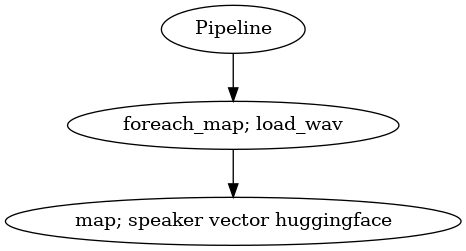Speaker Vector HuggingFace
Contents
Speaker Vector HuggingFace#
This tutorial is available as an IPython notebook at malaya-speech/example/speaker-vector-huggingface.
This module is language independent, so it save to use on different languages. Pretrained models trained on multilanguages.
This is an application of malaya-speech Pipeline, read more about malaya-speech Pipeline at malaya-speech/example/pipeline.
[1]:
import os
os.environ['CUDA_VISIBLE_DEVICES'] = ''
[2]:
from malaya_speech import Pipeline
import malaya_speech
import numpy as np
`pyaudio` is not available, `malaya_speech.streaming.pyaudio_vad.stream` is not able to use.
[3]:
import logging
logging.basicConfig(level=logging.INFO)
List available HuggingFace model#
[4]:
malaya_speech.speaker_vector.available_huggingface()
INFO:malaya_speech.speaker_vector:tested on VoxCeleb2 test set. Lower EER is better.
INFO:malaya_speech.speaker_vector:download the test set at https://github.com/huseinzol05/malaya-speech/tree/master/data/voxceleb
[4]:
| Size (MB) | Embedding Size | EER | |
|---|---|---|---|
| microsoft/wavlm-base-sv | 405.0 | 512.0 | 0.078274 |
| microsoft/wavlm-base-plus-sv | 405.0 | 512.0 | 0.066884 |
| microsoft/unispeech-sat-large-sv | 1290.0 | 512.0 | 0.203277 |
| microsoft/unispeech-sat-base-sv | 404.0 | 512.0 | 0.078282 |
| microsoft/unispeech-sat-base-plus-sv | 404.0 | 512.0 | 0.076128 |
Smaller EER the better model is.
Load HuggingFace model#
def huggingface(
model: str = 'microsoft/wavlm-base-plus-sv',
force_check: bool = True,
**kwargs,
):
"""
Load Finetuned models from HuggingFace.
Parameters
----------
model : str, optional (default='microsoft/wavlm-base-plus-sv')
Check available models at `malaya_speech.speaker_vector.available_huggingface()`.
force_check: bool, optional (default=True)
Force check model one of malaya model.
Set to False if you have your own huggingface model.
Returns
-------
result : malaya_speech.torch_model.huggingface.XVector class
"""
[5]:
model = malaya_speech.speaker_vector.huggingface()
[6]:
from glob import glob
speakers = [
'speech/example-speaker/khalil-nooh.wav',
'speech/example-speaker/mas-aisyah.wav',
'speech/example-speaker/shafiqah-idayu.wav',
'speech/example-speaker/husein-zolkepli.wav'
]
Pipeline#
[7]:
def load_wav(file):
return malaya_speech.load(file)[0]
p = Pipeline()
frame = p.foreach_map(load_wav).map(model)
[8]:
p.visualize()
/home/husein/.local/lib/python3.8/site-packages/networkx/readwrite/graphml.py:346: DeprecationWarning: `np.int` is a deprecated alias for the builtin `int`. To silence this warning, use `int` by itself. Doing this will not modify any behavior and is safe. When replacing `np.int`, you may wish to use e.g. `np.int64` or `np.int32` to specify the precision. If you wish to review your current use, check the release note link for additional information.
Deprecated in NumPy 1.20; for more details and guidance: https://numpy.org/devdocs/release/1.20.0-notes.html#deprecations
(np.int, "int"), (np.int8, "int"),
/home/husein/.local/lib/python3.8/site-packages/networkx/readwrite/gexf.py:220: DeprecationWarning: `np.int` is a deprecated alias for the builtin `int`. To silence this warning, use `int` by itself. Doing this will not modify any behavior and is safe. When replacing `np.int`, you may wish to use e.g. `np.int64` or `np.int32` to specify the precision. If you wish to review your current use, check the release note link for additional information.
Deprecated in NumPy 1.20; for more details and guidance: https://numpy.org/devdocs/release/1.20.0-notes.html#deprecations
(np.int, "int"), (np.int8, "int"),
[8]:

[9]:
r = p(speakers)
/home/husein/.local/lib/python3.8/site-packages/transformers/models/wavlm/modeling_wavlm.py:1755: UserWarning: __floordiv__ is deprecated, and its behavior will change in a future version of pytorch. It currently rounds toward 0 (like the 'trunc' function NOT 'floor'). This results in incorrect rounding for negative values. To keep the current behavior, use torch.div(a, b, rounding_mode='trunc'), or for actual floor division, use torch.div(a, b, rounding_mode='floor').
return (input_length - kernel_size) // stride + 1
Calculate similarity#
[10]:
from sklearn.metrics.pairwise import cosine_similarity
[15]:
cosine_similarity(r['speaker-vector-huggingface'])
[15]:
array([[1.0000001 , 0.4988824 , 0.36581534, 0.92033345],
[0.4988824 , 1.0000001 , 0.6961168 , 0.48723692],
[0.36581534, 0.6961168 , 1.0000002 , 0.38700205],
[0.92033345, 0.48723692, 0.38700205, 1.0000001 ]], dtype=float32)
Remember, our files are,
['speech/example-speaker/khalil-nooh.wav',
'speech/example-speaker/mas-aisyah.wav',
'speech/example-speaker/shafiqah-idayu.wav',
'speech/example-speaker/husein-zolkepli.wav']
